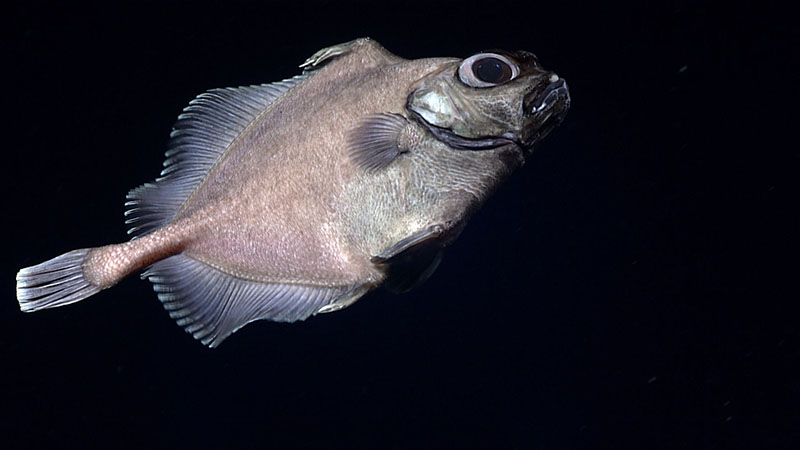
Peter J. Auster, Mystic Aquarium and University of Connecticut
This oreo fish was seen during Dive 09 of the 2021 North Atlantic Stepping Stones expedition, the first of two expedition dives on Yakutat Seamount. Video courtesy of NOAA Ocean Exploration, 2021 North Atlantic Stepping Stones: New England and Corner Rise Seamounts. Download largest version (mp4, 62.8 MB).
“Oreo” is a common name for a group of deep-sea fishes in the family Oreostomatidae. Most species are found in the Southern Ocean on continental slopes and seamounts. Their body form and behavior suggest they could be at home on any shallow tropical coral reef, amongst the triggerfish and butterflyfish. During our dives in the Corner Seamounts region here in the North Atlantic, we have observed one species observed repeatedly - the false boarfish, Neocyttus helgae.
Earlier NOAA Ocean Exploration expeditions across the New England and Corner Rise seamounts, and confirmed by our recent observations, revealed this species occurs in the 900 to 1,900-meter (2,953 to 6,234-foot) depth range and are encountered as single individuals or in pairs. They are associated with steep-sided seamount features as well as biological structures like corals. Species in this family generally feed on zooplankton like copepods and shrimps, which explains their tendency to hold position above seafloor features, pointed into the water current. This behavior allows them to maximize the rate they encounter drifting prey while remaining close to shelter from currents, allowing them to conserve energy when not feeding. The proximity to shelter also enhances avoidance of predators, like deep-sea sharks.

We saw several oreo fish during our dives on the Corner Rise Seamounts. This one was imaged at 1,208 meters (3,963 feet) during Dive 11 of the 2021 North Atlantic Stepping Stones expedition. Image courtesy of NOAA Ocean Exploration, 2021 North Atlantic Stepping Stones: New England and Corner Rise Seamounts. Download largest version (jpg, 692 KB).
Notable is their behavior that can only be interpreted as territorial defense. As in the video above, fish will parade in front of the remotely operated vehicle like an intruder and erect their dorsal spine. This signaling is akin to triggerfish defending nests and butterflyfish defending territories. Why would a deep-sea fish defend a territory? This investment in energy and potential for injury makes sense if this species, at least temporarily, identifies a habitat that optimizes encounters with prey and provides shelter, while reducing competition from other individuals of the same and similar species. If many other locations had similar ecological benefits, it would make more sense to simply retreat from intruders and relocate.
The seamounts across the western North Atlantic appear to serve as stepping stones for this species. These seamounts are rare “islands” of hardbottom habitat that jut upwards from the abyss into the depth range that produces conditions for this species to persist (e.g., temperature, food resources). Less than 10 years ago, we found this species also commonly occurs in small numbers in submarine canyons off southern New England.
This little fish is a good lesson demonstrating that we have much more to learn about life in the sea, taking a lesson from early naturalists about the value of exploring new places with an open mind. Grab a cookie and stay tuned to video from the deep-sea.
For additional information:
Moore, J. A., Auster, P. J., Calini, D., Heinonen, K., Barber, K., & Hecker, B. (2008). False boarfish Neocyttus helgae in the western North Atlantic. Bulletin of the Peabody Museum of Natural History, 49(1), 31-41.
Quattrini, A.M., Nizinski, M.S., Chaytor, J.D., Demopoulos, A.W., Roark, E.B., France, S.C., Moore, J.A., Heyl, T., Auster, P.J., Kinlan, B. & Ruppel, C. (2015). Exploration of the canyon-incised continental margin of the northeastern United States reveals dynamic habitats and diverse communities. PLoS One, 10(10), p.e0139904.
Published July 20, 2021